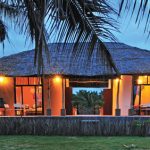-
Nature to the Rescue: Natural Blinds
March 2008
By Zeena Marikkar
With all the luxuries and richness of living in the tropics comes the inevitable glare which is best kept at bay. ‘Bamboo Tats’ or pelali as they are commonly known, are used to shield windows, pavilions and verandas in the most efficient manner. They also comfortably fill the eco-friendly niche – as reflected in the growing popularity of sustainable, biodegradable material.
They also comfortably fill the eco-friendly niche – as reflected in the growing popularity of sustainable, biodegradable material.
But bamboo tats are more than mere blinds, serving a practical function – they can also be used as a tool to enhance architectural spaces and interiors, to add form and give texture.
The local market offers tats made out of bamboo, cane or ekel, many of which are cottage industry products, supplied by individuals or small scale industries. These are made to measurement and can be made up to a maximum width of 10 feet and any height depending on the requirement. However the most practical manoeuvrable area for a single tat is 30 sq ft and up to 6 feet in width, weighed by an Arecanut bark strip at the bottom.
Bamboo tats are often used as an outdoor shielding device with the added application of a sealant. The horizontal bamboo strips bound by nylon threads need minimum maintenance and withstands 5-6 years of tropical weather: the hot sun and lashing rain. The more sleek indoor blinds are usually of ekel and cane and often more expensive than the bamboo version, but they also last longer with proper maintenance (a mere regular dusting). Roller mechanism and Roman fold systems of installation are both available with a few manufacturers, but the favourite is still the traditional form of the manual pulley.
 Bamboo blinds imported from Southeast Asia are also now available in the market, through a few retailers. These blinds, although more expensive than their local counterpart, offer more options in terms of aesthetics and architectural flexibility. They are usually available in a variety of colours of treated bamboo, woven in intricate patterns with nylon threading and are found in rolls of 4 – 5 feet, up to a maximum length of 30 feet.
Bamboo blinds imported from Southeast Asia are also now available in the market, through a few retailers. These blinds, although more expensive than their local counterpart, offer more options in terms of aesthetics and architectural flexibility. They are usually available in a variety of colours of treated bamboo, woven in intricate patterns with nylon threading and are found in rolls of 4 – 5 feet, up to a maximum length of 30 feet.
Roman folds or roller systems are both readily available when fixing, operated by smooth plastic rollers and cord. Tassels are generally fixed to the bottom of the cord for ease of operation. A cord lock in the mechanism helps to keep the blind at the desired height. Imported bamboo blinds are designed for exclusive indoor use and are not to be exposed to direct sunlight or moisture. If you prefer increased privacy, these blinds could be lined with a suitable fabric. Though exterior-use, local bamboo blinds are self-cleansing, interior blinds, both local and imported, need to be dusted regularly for enhanced durability.
Although of natural material, these blinds combine well with ultra modern interiors. They are found in versatile forms and placements, in offices, houses, hotels, and especially restaurants where they are also used as subtle and effective space dividers.
 The beauty and mystery of light filtered through the louvres in the bamboo blinds add an unmistakable charm to any space, especially in the tropics where sunshine is in abundance.
The beauty and mystery of light filtered through the louvres in the bamboo blinds add an unmistakable charm to any space, especially in the tropics where sunshine is in abundance.











